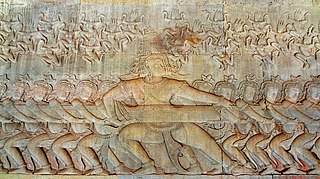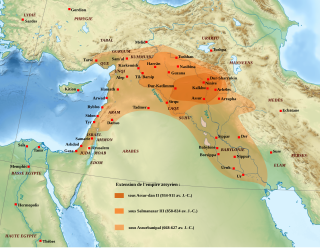
Assyria was a major ancient Mesopotamian civilization which existed as a city-state from the 21st century BC to the 14th century BC, then to a territorial state, and eventually an empire from the 14th century BC to the 7th century BC.

Tiglath-Pileser III was the king of the Neo-Assyrian Empire from 745 BC to his death in 727. One of the most prominent and historically significant Assyrian kings, Tiglath-Pileser ended a period of Assyrian stagnation, introduced numerous political and military reforms and more than doubled the lands under Assyrian control. Because of the massive expansion and centralization of Assyrian territory and establishment of a standing army, some researchers consider Tiglath-Pileser's reign to mark the true transition of Assyria into an empire. The reforms and methods of control introduced under Tiglath-Pileser laid the groundwork for policies enacted not only by later Assyrian kings but also by later empires for millennia after his death.

Asuras are a class of beings in Indian religions. They are described as power-seeking demons related to the more benevolent Devas in Hinduism. In its Buddhist context, the word is translated as "titan", "demigod", or "antigod".
Ashur was the second son of Shem, the son of Noah. Ashur's brothers were Elam, Arphaxad, Lud, and Aram.

Aššur (; Sumerian: 𒀭𒊹𒆠 AN.ŠAR2KI, Assyrian cuneiform: Aš-šurKI, "City of God Aššur"; Syriac: ܐܫܘܪ Āšūr; Old Persian: 𐎠𐎰𐎢𐎼 Aθur, Persian: آشور Āšūr; Hebrew: אַשּׁוּר ʾAššūr, Arabic: اشور), also known as Ashur and Qal'at Sherqat, was the capital of the Old Assyrian city-state (2025–1364 BC), the Middle Assyrian Empire (1363–912 BC), and for a time, of the Neo-Assyrian Empire (911–609 BC). The remains of the city lie on the western bank of the Tigris River, north of the confluence with its tributary, the Little Zab, in what is now Iraq, more precisely in the al-Shirqat District of the Saladin Governorate.
Ashur-nadin-ahhe II was king of Assyria from c. 1400 to 1391 BC. Preceded by Ashur-rim-nisheshu, he was succeeded by his brother, Eriba-Adad I.
Ashur-dan III was the king of the Neo-Assyrian Empire from 773 BC to his death in 755 BC. Ashur-dan was a son of Adad-nirari III and succeeded his brother Shalmaneser IV as king. He ruled during a period of Assyrian decline from which few sources survive. As such his reign, other than broad political developments, is poorly known. At this time, the Assyrian officials were becoming increasingly powerful relative to the king and at the same time, Assyria's enemies were growing more dangerous. Ashur-dan's reign was a particularly difficult one as he was faced with two outbreaks of plague and five of his eighteen years as king were devoted to putting down revolts.
Ancient Semitic religion encompasses the polytheistic religions of the Semitic peoples from the ancient Near East and Northeast Africa. Since the term Semitic itself represents a rough category when referring to cultures, as opposed to languages, the definitive bounds of the term "ancient Semitic religion" are only approximate, but exclude the religions of "non-Semitic" speakers of the region such as Egyptians, Elamites, Hittites, Hurrians, Mitanni, Urartians, Luwians, Minoans, Greeks, Phrygians, Lydians, Persians, Medes, Philistines and Parthians.
Ashur, Assur, may refer to:
The Asuras are a race of power-seeking deities in Hinduism.

Ashur Yousif born Abraham Yusef; was a professor and an ethnic Assyrian intellectual prior to World War I and the Assyrian genocide. He was Protestant, as was his wife Arshaluys Oghkasian, daughter of an Armenian Protestant minister. He studied at the Central Turkey College in Antep, and later became professor of Classical Armenian language at the Euphrates College in Harput. In 1909, Ashur started publishing a Turkish-language newspaper named Murshid Athuriyion. He also composed poems in Armenian and Turkish.

Ashur, Ashshur, also spelled Ašur, Aššur was the national god of the Assyrians in ancient time until their gradual conversion to Christianity between the 1st and 5th centuries AD.
Tukulti-Ninurta may refer to:

Ktav Ashuri also (Ktav) Ashurit, is the traditional Hebrew language name of the Hebrew alphabet, used to write both Hebrew and Jewish Babylonian Aramaic. It is often referred to as (the) Square script. The names "Ashuri" (Assyrian) or "square script" are used to distinguish it from the Paleo-Hebrew script.

The Neo-Assyrian Empire was the fourth and penultimate stage of ancient Assyrian history. Beginning with the accession of Adad-nirari II in 911 BC, the Neo-Assyrian Empire grew to dominate the ancient Near East throughout much of the 8th and 7th centuries BC, becoming the largest empire in history up to that point. Because of its geopolitical dominance and ideology based in world domination, the Neo-Assyrian Empire is by many researchers regarded to have been the first world empire in history. It influenced other empires of the ancient world culturally, administratively, and militarily, including the Babylonians, the Achaemenids, and the Seleucids. At its height, the empire was the strongest military power in the world and ruled over all of Mesopotamia, the Levant and Egypt, as well as parts of Anatolia, Arabia and modern-day Iran and Armenia.
The Old Assyrian period was the second stage of Assyrian history, covering the history of the city of Assur from its rise as an independent city-state under Puzur-Ashur I c. 2025 BC to the foundation of a larger Assyrian territorial state after the accession of Ashur-uballit I c. 1363 BC, which marks the beginning of the succeeding Middle Assyrian period. The Old Assyrian period is marked by the earliest known evidence of the development of a distinct Assyrian culture, separate from that of southern Mesopotamia and was a geopolitically turbulent time when Assur several times fell under the control or suzerainty of foreign kingdoms and empires. The period is also marked with the emergence of a distinct Assyrian dialect of the Akkadian language, a native Assyrian calendar and Assur for a time becoming a prominent site for international trade.

The Middle Assyrian Empire was the third stage of Assyrian history, covering the history of Assyria from the accession of Ashur-uballit I c. 1365 BC and the rise of Assyria as a territorial kingdom to the death of Ashur-dan II in 912 BC. The Middle Assyrian Empire was Assyria's first true period of ascendancy as an empire, although Assyrian kings had existed from perhaps as early as the 25th century BC, and from the 21st century BC Assyria had controlled trading colonies in Anatolia and had economic and military influence in Southern Mesopotamia, and from the late 19th century BC had been an integral part of the "Empire of Shamsi-Adad", sometimes called the Old Assyrian Empire. Though the empire experienced successive periods of expansion and decline, it remained the dominant power of Mesopotamia and often the entirety of West Asia throughout the period. In terms of Assyrian history, the Middle Assyrian period was marked by important social, political and religious developments, including the rising prominence of both the Assyrian king and the Assyrian national deity Ashur.
The post-imperial period was the final stage of ancient Assyrian history, covering the history of the Assyrian heartland from the fall of the Neo-Assyrian Empire in 609 BC to the final sack and destruction of Assur, Assyria's ancient religious capital, by the Sasanian Empire c. AD 240–250, though Assyria was to endure as the geopolitical entity of Asoristan until the mid 7th century AD. There was no single independent Assyrian state during this time, with Assur and other Assyrian cities instead falling under the control of the successive Median, Neo-Babylonian, Achaemenid, Seleucid and Parthian empires. The period was marked by the continuance of ancient Assyrian culture, traditions and religion, despite the lack of an Assyrian kingdom. The ancient Assyrian dialect of the Akkadian language went extinct however, completely replaced by Aramaic by the 5th century BC, a process that had begun during the Neo-Assyrian Empire.







